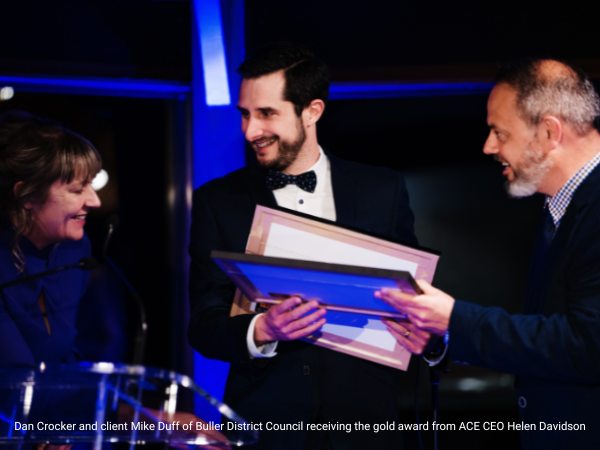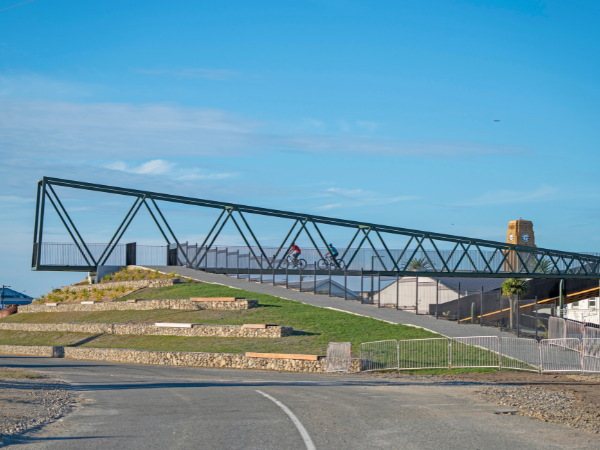Specialist bridge design firm, DC Structures Studio, were recognised for bringing the project to life through their in-house bridge engineering and architectural capability to deliver a fully co-ordinated, and uniquely original design, from concept all the way through to delivery on site.
What also made this project standout was DC structures Studio taking the time to listen to the needs of their client, Buller District Council, enabling them to see beyond the conventional solution and re-imagine their project into something original and exciting.
We recently had a kōrero with Dan Crocker, Technical Director of Bridge Engineering at DC Structures Studio, about his passion for creating bridges that communities take pride in and how supporting the client on design intent and helping identify the true nature of the opportunity led to an inspirational outcome for the Westport community.

You famously said “I love bridges” when receiving the gold at the ACE awards gala dinner – what were the aspects that made you so passionate about this particular project?
Ha ha… famously. I like it. I also sang Wonderwall on the bus home using the coach drivers PA. I guess with my poor vocal range that is probably now infamous!
I decided to do what the awards evening MC Melodie Robinson had done in sharing her passion for rugby. In my mind I thought to myself, I know this project inside out and upside down. I personally wrote the ACE Award submission I know why it had won. I decided to share that story. I decided to do exactly what they tell you not to do. Although I had a speech prepared, I decided to wing it! I literally said what came to mind in the moment. I decided to share my passion for the project, the client and Westport.
I wrote it down the next morning and I recall the opening lines of my speech as follows: “I LOVE BRIDGES. I love cool bridges. I love designing cool bridges for cool people. This is a cool bridge and we had a cool client. This is Mike my client [pointing to Mike Duff of Buller District Council smiling behind me]. Mike is a cool guy. The local community and iwi were extremely cool to work with. When I say cool client, I mean a client who understands us, a client who appreciates us, and a client who respects us. When I say cool project I mean projects with innovation, sustainability and complexity”. My speech then progressed to list all the cool innovations and features and discuss how the community have responded to the bridge.
I felt truly humbled and empowered by the number of people who came up to me afterward and congratulated me. The majority of those people whole heartedly patted me on the back and thanked me for my honesty. They thanked me for my authenticity. Most importantly they thanked me for sharing my passion.
There was a major turning point which changed the direction of the project – when you asked “Do you think a bridge inspired by pounamu would be better?” Can you tell us about that turning point?
Getting to know our client, and more importantly the communities they represent is really important to us. The early conversation we had with Mike Duff (project leader on behalf of Buller District Council) was a normal conversation we have with all of our clients. It started with a simple “tell me more about Westport.” What started as a story about the coal mining history of Westport and why a rail inspired bridge would be appropriate, quickly evolved into a conversation about opportunities to recognise mana whenua and showcase the treasured taonga of pounamu (greenstone) found on the West Coast. Mike explained that collaborating with local iwi Ngāti Waewae on the design would be fantastic for Buller, and also align with other strategic West Coast initiatives including the ‘pounamu pathway’ visitor experience centres currently in development.
It was in hearing Mike’s passion for the future of Westport and the direction it was heading that made the question “Do you think a bridge inspired by pounamu would be better?” seem almost rhetorical once it was asked. From there on, this simple question reset the whole direction and aspirations for this project.
How did inspiring the client on design intent lead to better outcomes?
Previous plans prepared for the client recommended a railway inspired truss footbridge. Understandably, a railway inspired bridge for a town with rich history in rail and coal mining seemed to make sense. However, it was being open to new ideas and challenging this conventional logic that enabled us to unearth the spirit, relationships, and hopes for the future. This approach yielded the best outcomes. Not only were we able to help them create something truly unique for Westport but we were able to capture the cultural significance with iwi.
Opening day (30 March 2022) was a joyous and fun experience for everyone involved. Ngāti Waewae presented a beautiful pounamu kōhatu (stone) gifted to the people of Buller, named E Toru Ngā Mea.
It is apparent that interest in the project if it were merely a conventional railway inspired truss, which are everywhere, would have been less enthusiastic and heart-felt. We believe we have helped create something that the Westport community can enjoy and take great pride in. We hope it is the start of a great love affair between Westport and their new bridge!
What were some of the main challenges you had to overcome for this particular project?
The biggest challenges were the very tight footprint and the tight budget. The bridge connects the town over the railway but has a road at either end. Essentially, we had to get up and over the railway and land again as quickly as possible while still having gradients suitable for all users. To make sure the bridge could fit to the footprint and achieve all the railway clearances etc. the bridge was fully modelled in 3D. This 3D model was used all the way through the design process and into construction and ensured a perfect fit and minimal changes on site. The 3D model was also a great vehicle for interaction with stakeholders and was used in 3D walk-throughs and visualisation to help the community understand what was happening.
Working to tight budgets is tricky but often rewarding. We knew we wanted to create something unique, but we also knew the trap of designing something ‘frivolous’ that doesn’t get built because it is too expensive. We used our understanding of cost-effective bridge forms and appreciation of bridge costing to make sure at all key stages that our design was on-track for the set budget.
Collaboration between the community, council and local iwi Ngāti Waewae elevated this project to the next level. How important is collaboration for great consulting and what are some of the top tips you’ve learnt along the way?
Best tip is start the conversation as early as possible. In this project Mike, our client, was always proactive and as soon as an idea was even floated he would discuss it with Ned Tauwhare, council’s Ngāti Waewae representative. Scrappy little doodles of ideas were sent. Sketches on photos were sent. Anything that showed what we were thinking was sent upfront. We often get bogged down thinking we need to present fully thought-out beautiful renders. More often than not our key stakeholders want more than anything to be part of the journey and not treated as a gatekeeper at the end.
I remember about 10 years ago, while working at Beca, I was due to attend a hui in Auckland and we were to present a footbridge concept to five different iwi groups. I asked my technical director what I should prepare. He said nothing. I thought he was bonkers, but after a few chats with him I understood. After introductions were made at the hui and I was handed the floor my opening line was: “Okay, so here is what we have so far…” and I pointed to a blank white board. I got a lot of puzzled faces looking back at me. I explained, “This is ground zero. This is the start of the journey. You are here at the start with us.” The mood in the room quickly changed from “show us what you have and we’ll see if we like it”, to “how do we design something cool together”. That bridge was the Hinaki Eel Trap Footbridge in South Auckland. That project was a turning point for me in understanding stakeholders and what they want from successful collaboration. Westport is a progression of that.
What impact has the bridge had on the community since it’s opening (on 30 March 2022)?
With the new connector pathways now joining Toki Bridge to the Kawatiri Coastal Trail, it will encourage people to explore the amazing natural beauty surrounding Westport. In the past 12 months Westport has been hit by multiple severe weather events and three state of emergencies, record flooding, and along with everyone else the impact of a global pandemic. One of the biggest successes of this project is that having a new and vibrant landmark in the centre of Westport acts as a visual way-finder for the hopes, dreams, and potential of the community. It is always so hard to get feedback from the end users. Perhaps the best way to sum this up is in the message accompanying the E Toru Nga Mea pounamu stone which sits proudly at the bridge entrance and reflects how the community feel about the bridge and what it stands for:
Whakapono – Belief
Tumanako – Hope
Ko te aroha – love
Wow, that is very cool feedback!
The community of Westport has demonstrated great strength and resilience in dealing with recent adversity. Hopefully the bridge can bring belief, hope, and love as needed for a prosperous future. Overall, we hope that the bridge acts as a symbol of pride for the community. As a design firm that is our primary goal, to create bridges that communities take pride in. We hope the Toki Bridge and the silhouette it creates remains unique to the Westport skyline.
What have you learnt through this project that you can share with your consulting colleagues?
Don’t be afraid to ask the silly questions and don’t be afraid to challenge conventional solutions if you think it is in your client’s best interest. Try to love what you do and work with others that love what they do.
If you were to challenge the industry to do one thing differently today, what would it be?
Celebrate. Celebrate your projects as much as you can especially within your team. Showcase your talent and passion. Yes, it’s cool to be humble. If we all remain humble and silent about the great things we are doing, the younger generation will not be inspired. Get your own teams excited about what they do.
Connect with Dan Crocker on LinkedIn or check out his team’s latest bridge designs at dcstructuresstudio.com.

Toki Poutangata Bridge in Westport. Photo credit // Nomad Audio and Video
